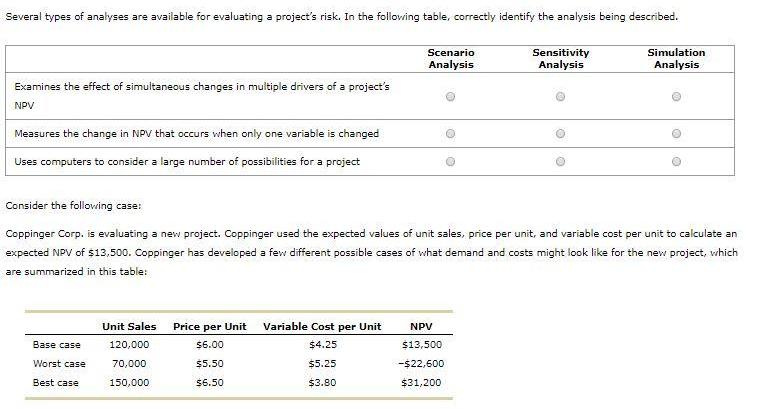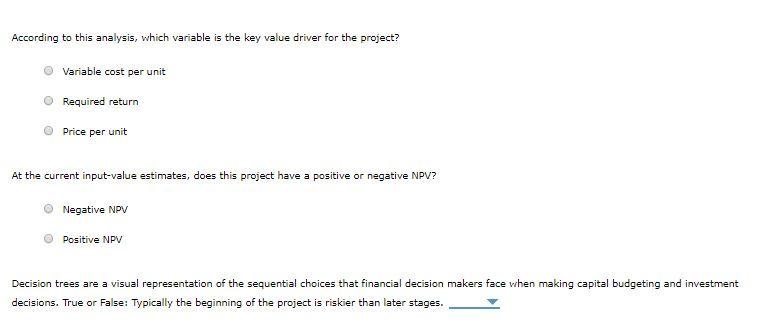Answered step by step
Verified Expert Solution
Question
1 Approved Answer
Several types of analyses are available for evaluating a project's risk. In the following table, correctly identify the analysis being described. Examines the effect



Several types of analyses are available for evaluating a project's risk. In the following table, correctly identify the analysis being described. Examines the effect of simultaneous changes in multiple drivers of a project's NPV Measures the change in NPV that occurs when only one variable is changed Uses computers to consider a large number of possibilities for a project Base case Worst case Best case Unit Sales 120,000 70,000 150,000 Consider the following case: Coppinger Corp. is evaluating a new project. Coppinger used the expected values of unit sales, price per unit, and variable cost per unit to calculate an expected NPV of $13,500. Coppinger has developed a few different possible cases of what demand and costs might look like for the new project, which are summarized in this table: Price per Unit Variable Cost per Unit $6.00 $4.25 $5.50 $6.50 Scenario Analysis $5.25 $3.80 Sensitivity Analysis NPV $13,500 -$22,600 $31,200 Simulation Analysis What kind of risk analysis is Coppinger using? Suppose Coppinger Corp. is evaluating a new capital budgeting project and conducting some basic risk analysis. First, it calculates the project's NPV at various levels for the project's key input variables. Coppinger next calculates the project's NPV at various prices per unit, plots the results on the accompanying graph, and then repeats this process separately for variable cost per unit and required return. This process is a , whose results are shown on the graph. NPV Millions of $1 200 Scenario analysis Simulation analysis Sensitivity analysis 120 40 -40 -120 -200 -20 -12 -4 Price per Unit 4 Required Return Variable Cost per Unit 12 20 DEVIATION (%1 According to this analysis, which variable is the key value driver for the project? Variable cost per unit Required return Price per unit At the current input-value estimates, does this project have a positive or negative NPV? Negative NPV Positive NPV Decision trees are a visual representation of the sequential choices that financial decision makers face when making capital budgeting and investment decisions. True or False: Typically the beginning of the project is riskier than later stages.
Step by Step Solution
★★★★★
3.33 Rating (177 Votes )
There are 3 Steps involved in it
Step: 1

Get Instant Access to Expert-Tailored Solutions
See step-by-step solutions with expert insights and AI powered tools for academic success
Step: 2

Step: 3

Ace Your Homework with AI
Get the answers you need in no time with our AI-driven, step-by-step assistance
Get Started


